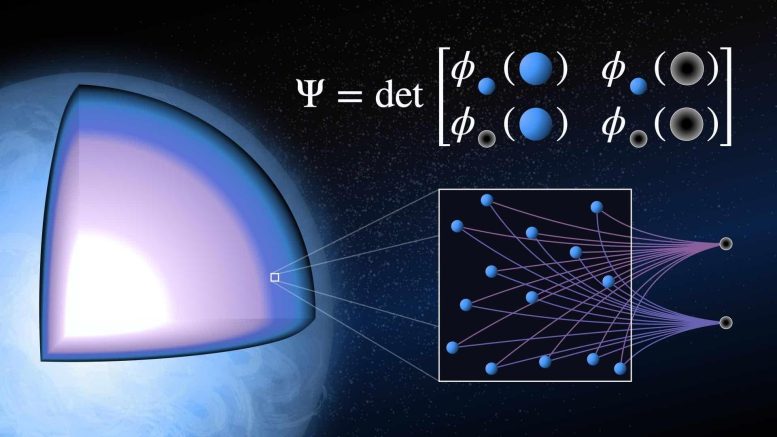
By U.S. Department of Energy December 3, 2024
Collected at: https://scitechdaily.com/revolutionary-ai-unlocks-the-superfluidity-secrets-of-neutron-stars/
Researchers find evidence of superfluidity in low-density neutron matter by using highly flexible neural-network representations of quantum wave functions.
A groundbreaking study employing artificial neural networks has refined our understanding of neutron superfluidity in neutron stars, proposing a cost-effective model that rivals traditional computational approaches in predicting neutron behavior and emergent quantum phenomena.
Neutron Superfluidity in Neutron Stars
The inner crust of a neutron star contains a fascinating phenomenon known as neutron superfluidity, where neutrons flow without resistance due to the absence of viscosity. Traditionally, researchers predict the properties of low-density neutron matter by assuming that neutrons pair up into “Cooper pairs,” a fundamental concept in quantum mechanics.
However, this study took a different approach, using artificial neural networks to achieve accurate predictions without relying on this assumption. By enhancing the standard “single-particle” model, the researchers introduced “hidden” neutrons, which mediate interactions among the “real” neutrons and capture complex quantum many-body correlations. This innovative method allows Cooper pairs to emerge naturally during the calculations, offering new insights into the quantum behavior of neutron matter.
Implications of Neutron Superfluidity Research
Understanding neutron superfluidity provides important insights into neutron stars. It sheds light on their cooling mechanisms, their rotation, and phenomena such as glitches—sudden changes in their rotation rate. While scientists cannot directly access neutron star matter experimentally, the fundamental interactions that govern this matter’s behavior are the same as those that govern atomic nuclei on Earth.
Researchers are working to construct nuclear interactions that are simple, yet predictive. Accurately solving the quantum many-body problem is a crucial part of assessing the quality of these interactions. This work uses simple interactions that agree well with previous calculations that assume much more complex interactions.
Quantum Phenomena in Low-Density Neutron Matter
Low-density neutron matter is characterized by fascinating emergent quantum phenomena, such as the formation of Cooper pairs and the onset of superfluidity. Researchers used artificial neural networks alongside advanced optimization techniques to study this density regime. Using a simplified model of the interactions between neutrons, the researchers calculated the energy per particle and compared the results to those obtained from highly realistic interactions. This approach is competitive with other computational methods at a fraction of the cost.
Reference: “Dilute neutron star matter from neural-network quantum states” by Bryce Fore, Jane M. Kim, Giuseppe Carleo, Morten Hjorth-Jensen, Alessandro Lovato and Maria Piarulli, 31 July 2023, Physical Review Research.
DOI: 10.1103/PhysRevResearch.5.033062
This work is supported by the Department of Energy (DOE) Office of Science, Office of Nuclear Physics, the DOE Office of Science, Office of Advanced Scientific Computing Research, Scientific Discovery through Advanced Computing (SciDAC) NUCLEI program, and the U.S. National Science Foundation. Numerical calculations used the Laboratory Computing Resource Center at Argonne National Laboratory and the computers of the Argonne Leadership Computing Facility, a DOE Office of Science user facility.

Leave a Reply